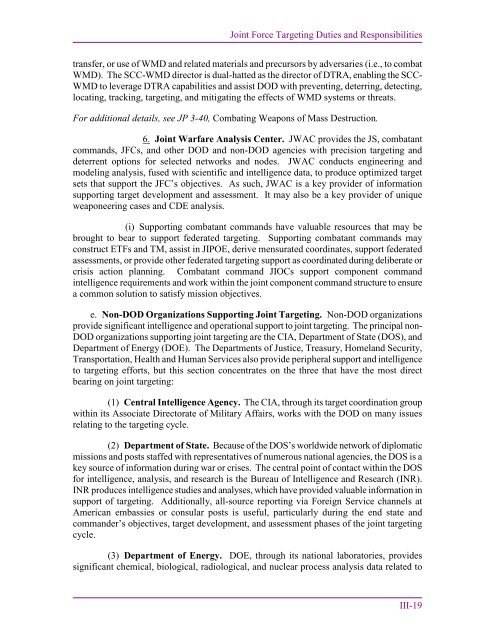Joint Targeting
1F87id9
1F87id9
You also want an ePaper? Increase the reach of your titles
YUMPU automatically turns print PDFs into web optimized ePapers that Google loves.
<strong>Joint</strong> Force <strong>Targeting</strong> Duties and Responsibilities<br />
transfer, or use of WMD and related materials and precursors by adversaries (i.e., to combat<br />
WMD). The SCC-WMD director is dual-hatted as the director of DTRA, enabling the SCC-<br />
WMD to leverage DTRA capabilities and assist DOD with preventing, deterring, detecting,<br />
locating, tracking, targeting, and mitigating the effects of WMD systems or threats.<br />
For additional details, see JP 3-40, Combating Weapons of Mass Destruction.<br />
6. <strong>Joint</strong> Warfare Analysis Center. JWAC provides the JS, combatant<br />
commands, JFCs, and other DOD and non-DOD agencies with precision targeting and<br />
deterrent options for selected networks and nodes. JWAC conducts engineering and<br />
modeling analysis, fused with scientific and intelligence data, to produce optimized target<br />
sets that support the JFC’s objectives. As such, JWAC is a key provider of information<br />
supporting target development and assessment. It may also be a key provider of unique<br />
weaponeering cases and CDE analysis.<br />
(i) Supporting combatant commands have valuable resources that may be<br />
brought to bear to support federated targeting. Supporting combatant commands may<br />
construct ETFs and TM, assist in JIPOE, derive mensurated coordinates, support federated<br />
assessments, or provide other federated targeting support as coordinated during deliberate or<br />
crisis action planning. Combatant command JIOCs support component command<br />
intelligence requirements and work within the joint component command structure to ensure<br />
a common solution to satisfy mission objectives.<br />
e. Non-DOD Organizations Supporting <strong>Joint</strong> <strong>Targeting</strong>. Non-DOD organizations<br />
provide significant intelligence and operational support to joint targeting. The principal non-<br />
DOD organizations supporting joint targeting are the CIA, Department of State (DOS), and<br />
Department of Energy (DOE). The Departments of Justice, Treasury, Homeland Security,<br />
Transportation, Health and Human Services also provide peripheral support and intelligence<br />
to targeting efforts, but this section concentrates on the three that have the most direct<br />
bearing on joint targeting:<br />
(1) Central Intelligence Agency. The CIA, through its target coordination group<br />
within its Associate Directorate of Military Affairs, works with the DOD on many issues<br />
relating to the targeting cycle.<br />
(2) Department of State. Because of the DOS’s worldwide network of diplomatic<br />
missions and posts staffed with representatives of numerous national agencies, the DOS is a<br />
key source of information during war or crises. The central point of contact within the DOS<br />
for intelligence, analysis, and research is the Bureau of Intelligence and Research (INR).<br />
INR produces intelligence studies and analyses, which have provided valuable information in<br />
support of targeting. Additionally, all-source reporting via Foreign Service channels at<br />
American embassies or consular posts is useful, particularly during the end state and<br />
commander’s objectives, target development, and assessment phases of the joint targeting<br />
cycle.<br />
(3) Department of Energy. DOE, through its national laboratories, provides<br />
significant chemical, biological, radiological, and nuclear process analysis data related to<br />
III-19


